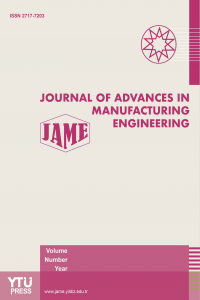Investigation of the prediction capability of Yld89 yield criterion for highly anisotropic sheet materials
Investigation of the prediction capability of Yld89 yield criterion for highly anisotropic sheet materials
___
- [1] Hershey, A.V. (1954). The plasticity of an isotropic aggregate of anisotropic face centered cubic crystals, Journal of Applied Mechanics, 21, 241-249.
- [2] Hosford, W.F. (1972). A generalized isotropic yield criterion, Journal of Applied Mechanics, 39, 607-609.
- [3] Barlat, F., Richmond, O. (1987). Prediction of tricomponent plane stress yield surfaces and associated flow and failure behavior of strongly textured F.C.C polycrystalline sheets, Materials Science and Engineering, 95, 15-29.
- [4] Bassani, J.L. (1977). Yield characterization of metals with transversely isotropic plastic properties, International Journal of Mechanical Sciences, 19, 651-660.
- [5] Budiansky, B. (1984). Anisotropic plasticity of plane-isotropic sheets, Studies in Applied Mechanics, 6, 15-29.
- [6] Hill, R. (1948). A theory of the yielding and plastic flow of anisotropic metals, Proceedings of the Royal Society of London Series A Mathematical and Physical Sciences, 193(A), 281-297.
- [7] Woodthorpe, J., Pearce, R. (1970). The anomalous behavior of aluminum sheet under balanced biaxial tension, International Journal of Mechanical Sciences, 12, 341-347.
- [8] Hill, R. (1979). Theoretical plasticity of textured aggregates, Mathematical Proceedings of the Cambridge Philosophical Society, 85, 179-191.
- [9] Hill, R. (1990). Constitutive modeling of orthotropic plasticity in sheet metals, Journal of the Mechanics and Physics of Solids, 38, 405-417.
- [10] Hill, R. (1993). A user-friendly theory of orthotropic plasticity in sheet metals, International Journal of Mechanical Sciences, 35, 19-25.
- [11] Lin, S.B., Ding, J.L. (1996). A modified from of Hill’s orientationdashdependent yield criterion for orthotropic sheet metals, Journal of the Mechanics and Physics of Solids, 44, 1739-1764.
- [12] Barlat, F., Lian, J. (1989). Plastic behavior and stretchability of sheet metals. Part I: a yield function for orthotropic sheets under plane stress conditions, International Journal of Plasticity, 5, 51-66.
- [13] Barlat, F., Lege, D.J., Brem, J.C., Warren, C.J. (1991b). Constitutive behavior for anisotropic materials and application to a 2090-T3 Al-Li alloy, Modeling the Deformation of Crystalline Solids, Warrendale, pages 189-203.
- [14] Stoughton, T.B., Shi, M.F., Huang, G., Yoon, J.W. (2013). Material characterizations for benchmark 1 and benchmark 2, AIP Conference Proceedings, 1567(1), 9-14.
- [15] Nocedal, J., Wright, S.J. (2006). Numerical Optimization, Springer, 2nd Ed., pages 563-592, United States of America.
- ISSN: 2717-7203
- Başlangıç: 2020
- Yayıncı: Yıldız Teknik Üniversitesi
Influence of variable cutting surface contact area on the components of cutting forces and accuracy
Esreb DZHEMILOV, Ruslan DZHEMALYADINOV, Eskender BEKIROV
Hamaid KHAN, Gürkan TARAKÇI, Mustafa BULDUK, Ebubekir KOÇ
Weibull distribution of selective laser melted AlSi10Mg parts for compression testing
